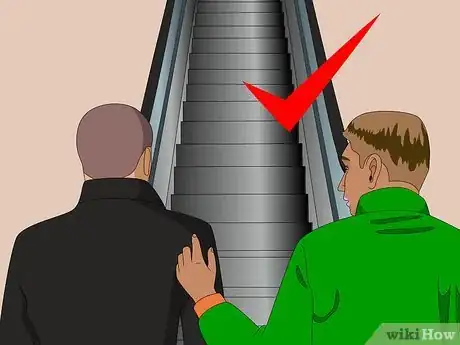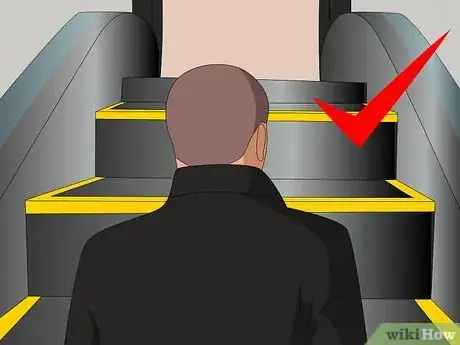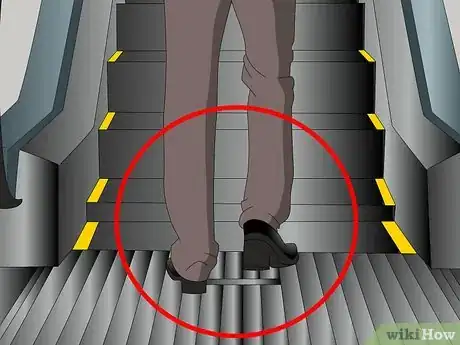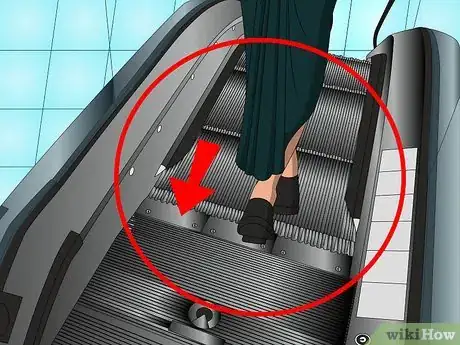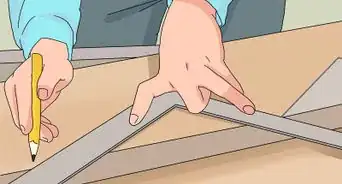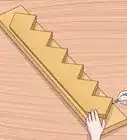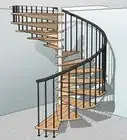This article was co-authored by wikiHow Staff. Our trained team of editors and researchers validate articles for accuracy and comprehensiveness. wikiHow's Content Management Team carefully monitors the work from our editorial staff to ensure that each article is backed by trusted research and meets our high quality standards.
This article has been viewed 102,480 times.
Learn more...
Getting on and off an escalator is simple for most people. However, some people are scared of riding an escalator because of a previous bad experience, stories they may have heard, warning signs or just because escalators are big and make a lot of noise. With practice and caution, anyone can ride an escalator safely and quickly.
Steps
Entering the Escalator
-
1Know when to take the elevator instead. If you are using a cane, a walker, or a wheelchair, it’s not safe for you to ride an escalator. Similarly, if you have a lot of rolling luggage or have a wheeled stroller, don’t use an escalator. If your luggage or stroller overbalances, they will fall over and roll. This could injure any children in the stroller and injure the passengers behind you.[1]
-
2Prepare yourself to enter the escalator. Stand in front of the escalator with your bags and packages grasped firmly in one hand. If there are any children with you, hold them with one hand. It’s important to have a hand free to hold the handrail when you enter the escalator.
- Make sure you’re entering the correct escalator – the stairs should be moving in the direction of your path, not towards you.
Advertisement -
3Step carefully onto the escalator. Stand near the center of the steps and extend a foot forward. Aim for the middle of the step.[2] Extend your free hand and grab the handrail as you move. Once you step onto the escalator, quickly step up with your other foot as well. Keep a firm grip on the handrail.
- Be especially cautious when wearing Crocs. Soft shoes such as Crocs can be dangerous when riding escalators as they can get easily stuck in moving parts. If you wear soft shoes onto the escalator, it is especially important to stand on the center of the step to avoid injury.[3]
-
4Plan your practice time. If you’re nervous about using an escalator and need some time to gather your courage, consider practicing early in the morning or late at night. Hopefully there will be less people during these hours, allowing you to take all the time you need without inconveniencing anyone. Similarly, have a friend stand behind you and usher others away to give you more time to ready yourself.
Riding the Escalator
-
1Stand properly on the escalator. Always face the direction of movement. If you face the wrong way on an escalator, you risk falling and injuring yourself. Remember, stand at the center of the step with your feet away from the sides, especially if you’re wearing sandals or Crocs. Similarly, keep an eye on loose clothing and make sure it doesn’t get stuck.[4]
- Never sit on the escalator step, even if you’re tired. It’s dangerous for you as well as for other passengers.
- Stand to the right on the steps so that people can walk past you if they're in a hurry. This is considered escalator etiquette. However, remember walking on the escalator is not considered safe behavior.
-
2Keep a steady grip on the handrail. Hold the handrail firmly with your back straight and arm relaxed. Don’t lean on the handrail or bend over the sides. Using the handrail properly will help improve your balance while you ride and help you catch yourself if you accidentally fall.
-
3Be careful with your bags. Don’t rest bags or other items on the handrail as the handrail is only for hands. Keep all bags and packages firmly held in your free hand. Don’t rest them on the steps either as they can get caught in the moving parts. If you have too many bags to hold with one hand, it may be better to take the elevator.
Exiting the Escalator
-
1Step off promptly. When nearing the top of the escalator, step off promptly and confidently. If you hesitate, you will end up falling onto the floor and potentially injuring yourself. To step off, simply lift your foot and place it on the stationary metal plate at the top of the escalator.[5] Release the handrail and continue walking forward.
-
2Keep loose clothing clear of the top step. It’s easy for small, light objects such as the hems of clothing to get “pinched” here. Make sure your loose clothing is either gathered in your hand or high enough from the escalator that it won’t get caught. Some people believe that an escalator can reach out and “grab” you as you ride. This is a common myth. As long as you keep your shoes and loose clothing away from moving parts, you will be fine.
- If your clothing gets caught, try to press the emergency stop button[6] at the top or bottom of the escalator. If this doesn’t work, try to get out of the clothing. It’s better to be embarrassed and naked than injured!
-
3Move away from the exit area quickly. If you dawdle at the exit you could cause an accident. After all, the people moving towards you on the escalator can’t control their speed. If you block the exit, they will simply run into you. Instead, walk quickly away from the exit area before setting down your bag or stopping.[7]
Community Q&A
-
QuestionWhat should I do if I'm afraid of heights?
 Community AnswerThere should also be an elevator and stairs nearby that you could use instead.
Community AnswerThere should also be an elevator and stairs nearby that you could use instead. -
QuestionThere is some bit of imbalance when getting on and off of the escalator,why?This imbalance comes from the speed differential between you and the escalator. You are walking at speed X, while the escalator is moving at speed Y. Once you get on, you get a little nudge as that speed difference is absorbed by your balance center and muscles.
-
QuestionI'm scared to try this. What should I do?
 Community AnswerDon't panic. Panic will make you unsteady, more scared, and more likely to fall. Just follow the steps and carefully step on to the escalator, hold on to the rail and keep steady. Take a confident friend with you to walk you through it the first few times.
Community AnswerDon't panic. Panic will make you unsteady, more scared, and more likely to fall. Just follow the steps and carefully step on to the escalator, hold on to the rail and keep steady. Take a confident friend with you to walk you through it the first few times.
Warnings
- Don’t daydream while riding an escalator. Pay attention to what’s going on around you.⧼thumbs_response⧽
- If you are wearing soft shoes such as Crocs or flip-flops, exercise extra caution as you can get your toes caught in the cracks between steps.⧼thumbs_response⧽
References
- ↑ http://www.otis.com/site/us/pages/EscalatorandMovingWalkwaySafety.aspx
- ↑ http://www.otis.com/site/us/pages/EscalatorandMovingWalkwaySafety.aspx
- ↑ http://www.hog.org/publications/detail/escalators-dangerous-for-children-in-crocs
- ↑ http://www.otis.com/site/us/pages/EscalatorandMovingWalkwaySafety.aspx
- ↑ http://www.otis.com/site/us/pages/EscalatorandMovingWalkwaySafety.aspx
- ↑ https://www.sterlingelevatorcons.com/white-papers/escalator-safety-tips-myths-truths/
- ↑ http://www.neii.org/safety_escalator.cfm
